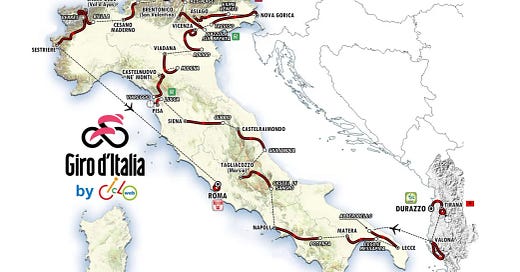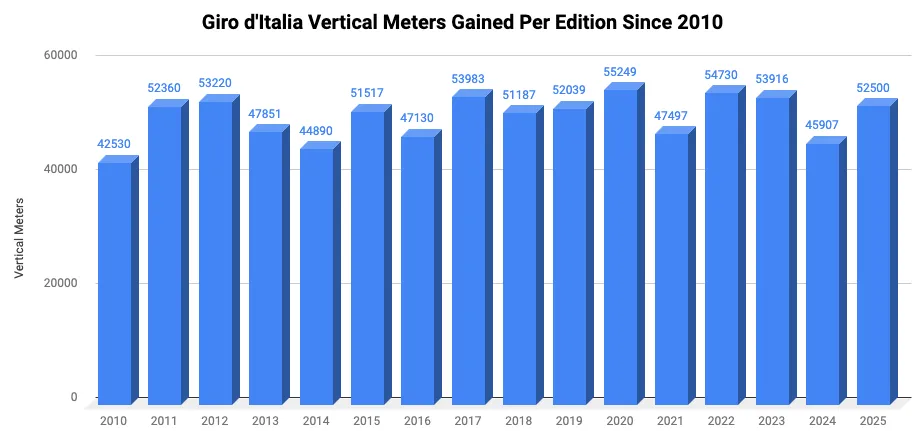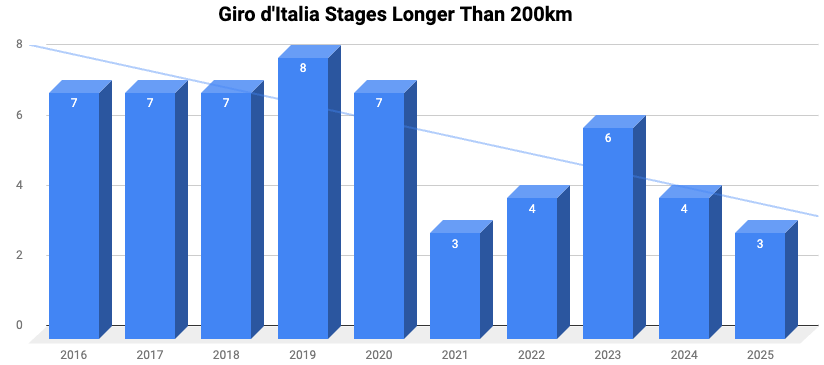2025 Giro d'Italia Pre-Race Cheat Sheet
Breaking down all the need-to-know information as we head into the first Grand Tour of the 2025 season
BTP will provide daily breakdowns for premium subscribers during the Giro d’Italia, which kicks off tomorrow, Friday, May 9th. Get 50% off the price of an annual plan by signing up before the end of the Giro’s first weekend.
The 2025 Giro d’Italia, which begins tomorrow in Durrës, Albania, and finishes in three weeks’ time in Rome, features an intriguing, if not slightly top-heavy start list of General Classification contenders, with the heavy pre-race favorites, Primož Roglič and Juan Ayuso, clearly separated from the rest of the field. While the battle for the overall win will almost certainly fall into the familiar Giro battle of slowly simmering to a boil as the mountains get higher and the terrain harder in the final week, with race organizer RCS including a punchy foreign start in Albania, with two hilly stages and an individual time trial, we should still get some early entertainment due to some early separation in the GC and thrilling battles for stage wins amongst stars like Wout van Aert, Mathieu van der Poel and Tom Pidcock.
2025 Giro d’Italia Route Overview:
2025 Giro d’Italia Stage List
Stage 1: Durrës - Tirana (164km)-hills
Stage 2: Tirana - Tirana (13.7km)-individual time trial
Stage 3: Vlorë - Vlorë (160km)-hills
Rest Day #1: May 12th
Stage 4: Alberobello - Lecce (187km)-flat
Stage 5: Ceglie Messapica - Matera (144km)-hills
Stage 6: Potenza - Napoli (226km)-hills
Stage 7: Castel di Sangro - Tagliacozzo (168km)-mountains w/summit finish
Stage 8: Giulianova - Castelraimondo (197km)-medium mountains
Stage 9: Gubbio - Siena (181km)-hills w/gravel sectors
Rest Day #2: May 19th
Stage 10: Lucca - Pisa (28.6km)-individual time trial
Stage 11: Viareggio - Castelnovo ne’ Monti (185km)-hills
Stage 12: Modena - Viadana (172km)-flat
Stage 13: Rovigo - Vicenza (180km)-hills
Stage 14: Treviso - Nova Gorica (186km)-flat
Stage 15: Fiume Veneto - Asiago (214km)-mountains
Rest Day #3: May 26th
Stage 16: Piazzola sul Brenta - San Valentino di Brentonico (199km)-mountains w/summit finish
Stage 17: San Michele all’Adige - Bormio (154km)-mountains
Stage 18: Morbegno - Cesano Maderno (144km)-flat
Stage 19: Biella - Champoluc (166km)-mountains
Stage 20: Verrès - Sestriere: (203km)-mountains w/summit finish
Stage 21: Rome - Rome (141km)-flat
Breakdown by Stage Type:
7 Mountain Stages
3 Summit Finishes
5 Flat(ish) Stage
7 Hilly Stages
38 gravel kms
2 Individual Time Trials
42.3 total kms
Three Course Takeaways
1) Over the last ten seasons, the Giro d’Italia has cemented its image as the Grand Tour of the time trial by averaging more individual time trial kilometers per edition than either of the other two grand tours (Tour de France and Vuelta a España).
However, in 2025, it is finally jumping on the bandwagon of minimizing Grand Tour kilometers by featuring just 42 kilometers against the clock, putting it in line with the 2025 Tour de France (44km), but still above the famously individual time trial-light Vuelta a España (26km).
While trimming the volume of time trial kilometers, the Giro has also drastically increased the total number of climbing meters.
2) Even with the Giro trimming the number of time trial kilometers and increasing the amount of climbing, it isn’t obvious that this will change the eventual outcome since the top GC riders, like Roglič and Ayuso, are both incredibly adept at putting time into their rivals on both time trials and climbs (after all, what is a long alpine climb if not a time trial where weight is slightly more important than aerodynamics).
In fact, the data is incredibly clear that a harder course doesn’t necessarily create a racing situation in which climbers or time trialists have an advantage.
Some of the easier courses in recent years (courses with low vertical meters gained to time trial kilometers ratios) have been won by riders with relatively poor time trial abilities, like Richard Carapaz in 2019, while some of the hardest, like 2012, have been won by riders not considered elite climbers (Ryder Hesjedal).
Past Winner List, Specialty & Course Difficulty Rating*:
2025: ?, 12.4
2024: Tadej Pogačar, hybrid time trialist/climber/strongman, 6.3
2023: Primož Roglič, hybrid time trialist/climber, 7.4
2022: Jai Hindley, climber, 19.5
2021: Egan Bernal, climber, 12.2
2020: Tao Geoghegan Hart, climber, 8.3
2019: Richard Carapaz, climber, 8.5
2018: Chris Froome, hybrid time trialist/climber, 11.5
2017: Tom Dumoulin, hybrid time trialist/climber, 7.7
2016: Vincenzo Nibali, pure climber, 7.5
2015: Alberto Contador, climber, 8.6
2014: Nairo Quintana, pure climber, 6.4
2013: Vincenzo Nibali, climber, 6.3
2012: Ryder Hesjedal, hybrid climber, 14.1
2011: Alberto Contador, climber, 13.32010: Ivan Basso, pure climber, 11.4
*The higher the number, the harder the course
Part of the reason for the lack of correlation between on-paper course difficulty and the rider profile of the winner is that the Giro is a much more wide-open and less controlled race than the Tour de France due to the top GC teams not sending their top-tier squads, which means they often lack the firepower to control the race as they would in other Grand Tours.
However, while this open dynamic has allowed riders who lack the consistency or time trial prowess to win the Tour, like Richard Carapaz, to get up the road and gain valuable ‘cushion’ time, the presence of extremely strong squads from the two top GC teams, UAE and RedBull-Bora-hansgrohe, could make this year’s Giro mirror the uber-controlled nature of the Tour de France.
3) Even if the number of vertical meters has returned to traditional levels, the 2025 Giro d’Italia will feature stages with an average of ‘just’ 162.5 kilometers per stage. This is a massive reduction from the past decades, even down from the already-reduced nine-year average of 164.2km.
As shown below, the trendline for average stage length is steadily decreasing.
Combined with higher race speeds, this is causing the race to shrink significantly.
For example, in 2024, the race had 14% less volume than in 2012 (Tadej Pogačar’s winning time of 79:14 vs Ryder Hesjedal’s time of 91:39).
In addition to a shorter average distance, the Giro, to eliminate the ultra-long, often actionless slogs of recent editions, has continued to significantly reduce the number of stages over 200 kilometers, which are thankfully following a downward year-over-year trendline.
To put into perspective how out-of-control these ultra-long stages had become, in 2023, there were ten 200km+ stages across the sport’s three grand tours, and the Giro accounted for 60% of those.
Outside of eliminating ultra-long stages, RCS has also halved the number of summit finishes in 2025 from 2024 (3 vs 6), which could actually keep the GC battle more open by limiting the number of time bonuses Roglič can collect.
Another lever they have pulled is to sequester the big mountain set pieces almost entirely to the third week (which is difficult, even with the Giro sadly skipping the Dolomites for 2025) and litter the opening week with punchy stages that will force the GC contenders to be on their toes while Classics stars like Van Aert and Pedersen fight for stage wins and to see who can grab, and hold, the race lead until the high mountains arrive (as well as win the eventual points jersey).
Who Will Win?
While there is a wealth of riders with past success at the Giro, like Jai Hindley (winner of the 2022 Giro), Richard Carapaz (winner of the 2019 Giro), Nairo Quintana (winner of the 2014 Giro), Dani Martinez (2nd at the 2024 Giro), and riders like Adam Yates, Simon Yates and Antonio Tiberi, who have all had Grand Tour success in recent years, their 2025 form isn’t at the current level to seriously challenge for the overall win.
Serious Overall Win Contenders:
Instead of one of the wide swath of big names with past success at Grand Tours, I believe a smaller group of in-form competitors will contest the eventual overall win and podium.
Primož Roglič (35): Veteran rider who has won 5 out of the last 7 Grand Tours he has completed, and finished on the podium for all of them.
Pros:
He has nearly as many Grand Tours as the rest of the field combined.
Despite a reputation for crashing, he has only failed to finish a single non-Tour de France Grand Tour in his entire career.
Won the Giro the last time he raced it (2023).
Cons:
The crash-heavy reputation does have some truth to it, especially near the end of busy and hectic stages, which we may see a lot of early in this Giro.
At 35, he's one of the oldest riders in the race and is nearly the maximum age that riders are able to contend for wins at Grand Tours.
Juan Ayuso (22): Arguably the most naturally gifted GC rider in the race with an elite climbing and time-trialing combo.
Pros:
Impressive podium at the 2022 Vuelta at just 19.
Supported by a deep and experienced UAE team.
Cons:
Has yet to seriously challenge for a Grand Tour over three full weeks.
Still prone to inconsistency and struggles with race maturity at times, especially against top competition.
Select Podium Challengers
Mikel Landa (35) Veteran climber with multiple top-5 Grand Tour finishes and the freedom to lead his Soudal-Quickstep team.
Pros:
Has a strong track record of top five finishes in his career, racking up a total of seven, with a podium placing the last time he raced the Giro back in 2023.
Often flies under the radar and performs best when the pressure is low.
Cons:
Has never seriously challenged for the win at a Grand Tour despite years of trying.
Prone to random bad days that sink overall hopes.
Tends to fall behind in time trials, but isn’t so much better at climbing than the others that he can make the time up.
Derek Gee (27): An up-and-coming former track rider with the ability to produce an incredible amount of raw power for sustained periods, which will come in handy on the long climbs at this Giro.
Pros:
Has performed well in three stage races this season, 1st at O Gran Camiño, 3rd at Tour of the Alps, and 4th at Tirreno-Adriatico.
Only emerged as a GC rider last year, which means he has the ability to continue to improve.
Hinted at an incredibly high ceiling at the 2023 Giro, where he got into seven breakaways, and still had enough left in the tank to finish second on Stage 19, the race’s hardest mountain stage.
Cons:
Has not proven the ability to compete for a Grand Tour podium over three weeks.
Egan Bernal (28): A former Tour de France winner (2019) who has won the Giro in the recent past (2021) due to an elite climbing pedigree.
Pros:
Slowly returning to form post-injury and has shown flashes of promise.
Has looked solid, but not great, after winning the Colombia Road Race and Time Trial National Championships.
Cons:
Unclear if he has the raw power to hang with the best on the longest, most difficult climbs and in time trials.
Antonio Tiberi (23). Young Italian talent that flashed potential with a fifth place overall at last year’s Giro d’Italia
Pros:
Has a strong track record of grabbing strong placings in elite stage races, like third overall at Tirreno-Adriatico, despite his young age.
Cons:
Left the recent Tour of the Alps with a stomach illness, which isn’t a great way to enter the race.
Where/How to Watch
When: Friday, May 9th-Sunday, June 1st, 6:30am(ish)-11:00am(ish) ET
How: Max (USA), Flobikes (Canada), Discovery+/Eurosport/Max/TNT Sports (Europe)








